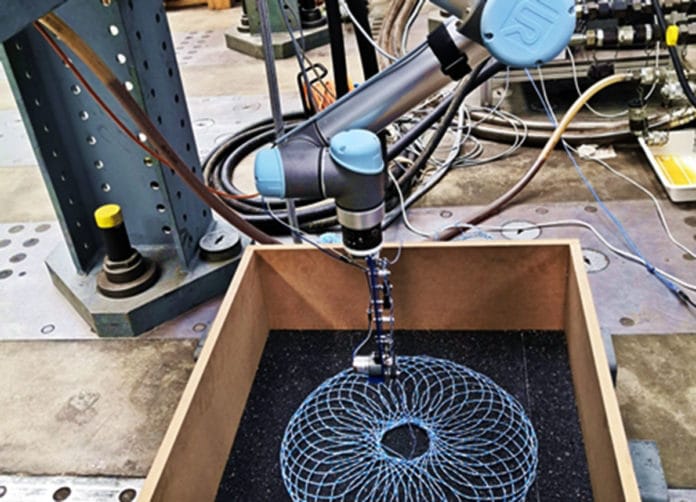Empa researchers are investigating how roads could be reinforced with simple means and recycled easily after use. In this effort, they have demonstrated how patterns of string carefully laid by robotic arms can be used to bind asphalt together for a more sustainable roadbuilding process.
The new process would remove the need for environmentally damaging bitumen and would also make it easier to recycle road materials. A new type of mechanical reinforcement is intended to change the typical structure of the road surface and help save valuable resources in the future or even recycle road surfaces altogether.
“We want to find out how a recyclable pavement could be produced in the future. To do this, we are using digitalized construction methods in road construction for the first time,” explains Martin Arraigada from Empa’s Concrete & Asphalt lab.
In an experiment, pillars piled up purely from strings and gravel demonstrated that outstanding stability could be achieved by simply interlocking the gravel with a thread – without any cement as a binder. The gravel pillars reached a height of 80 cm and a diameter of 33 cm and were capable of withstanding a pressure of 200 kN, which corresponds to a load of 20 tonnes.
This made the team think if a similar technique could be applied to road construction, where asphalt – also consists of rocks of various sizes and a binder, bitumen – is used.
A string-reinforced road surface could offer a number of advantages over the use of bitumen, which is extracted from crude oil and generates air pollutants during production and use.
For their experiments, the researchers deployed a robotic arm to stack five layers of gravel and thread on top of each other in a test box in a pre-programmed pattern. The floor of the box was covered with a rubber mat that fixes the whole package to the ground. The string is exactly the same as the one used by every Swiss citizen for bundling waste paper shows that Empa researchers are breaking completely new (and cost-effective) ground here.
The gravel-thread package is then loaded with a rotating plate and with pressure. The load tests showed that the subsurface road material made of gravel stones and thread could withstand a pressure of 5 kN – half a tonne – without the stones moving much. The researchers model everything in 3D on the computer using the Discrete Element Method (DEM), which helped them track the movement of individual stones and the tensile forces acting on the thread.
The research of Martin Arraigada and Saeed Abbasion has not yet resulted in a final product that is ready to be used in road construction. However, their research provides a lot of innovative potentials to get closer to a recyclable and possibly rollable road pavement with simple means.
